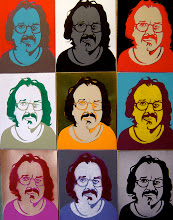Background
Scholarship on Johannes Vermeer includes a lot of speculation and conjecture. He lived and worked 350 years ago, he was not famous in his own time, and he only painted about forty pictures. The records are skimpy. The Geographer was painted in 1668 and 1669 when he
would have been 36. It is one of the few paintings that he signed and dated.
Beyond that we are in the territory of subjective analysis.
At the time the painting was done,
there were three men who shared the same birth year -1632 - living in a
seven-mile radius: Vermeer, Anthony Van Leeuwenhoek, and Baruch Spinoza.
Besides their birth year and geographic proximity, the three men shared an interest in
lenses. Spinoza ground glass into lenses for both microscopes and telescopes.
He was also one of the most influential thinkers the world has ever seen.
Vermeer probably used lenses and some sort of camera obscura setup to get the
incredible realism and perspective in his paintings. Vermeer may have used Spinoza’s lenses. Van Leeuwenhoek was
well known for his discoveries with the microscope but was also described as
being skilled in "navigation, astronomy, mathematics, philosophy and
natural sciences.” He may have used Spinoza’s lenses. He may have been the
model for The Geographer. He may have commissioned the painting and advised
Vermeer on the right kind of instruments, maps, and globes to include in it.
There is no historical proof for any of these possible connections.
What is clear is that these three
men were living in a time and place where people were beginning to understand
the world in a new way. The Netherlands were relatively tolerant and a place
where artists, scientists, and philosophers could strike out into new
territory. Whether they knew each other or not, they were in the vanguard of
The Enlightenment, The Age of Reason.
As a point of reference, in 1632 –
the same year Vermeer, Van Leeuwenhoek, and Spinoza were born – Galileo
published Dialogue explaining the
reasons to believe that the sun, and not the earth, was the center of the
universe. Galileo had been hounded and threatened with torture for heresy for most
of his life. When he published Dialogue, he was tried, found guilty, and imprisoned by the Inquisition. He was
never again a free man.
The Geographer by Johannes Vermeer 1668-1669
I take the measure of things.
I calculate and triangulate.
I hypothesize and investigate.
I want to know the size, shape, weight, distance
Of… everything.
Others get by on faith.
They believe what they believe because they believe it.
When I wake, my head is a buzz with questions.
Certainty flies out the window,
Leaving behind doubts, hopes, ideas, dreams.
They won’t leave me in peace. Thank God.
I bear the believers no ill will,
Even though they sit and wait for me to go too far.
They quote me the bible:
“…blessed are those who have not seen and
yet have believed.”
I am a doubting
Thomas!
If the risen Christ stood before me,
I would put my
finger in his side.
I would touch
his stigmata!
I’d put his blood under my microscope.
I don’t even want to know.
I just want to find out.
I can breathe and stretch in Delft. Thank
God.
In other times and places,
I would have danced in red-hot shoes,
Inhaled water instead of air,
Knelt in the sand waiting to feel the sword
on my neck.
They ask me if I have no beliefs.
I shrug and move on,
But, I think, “Yes. I believe in progress.”
I believe soon free thought will be taken
for granted.
I believe soon no one will die
Or face torture
For understanding the world in a different
way.
Thanks God.


No comments:
Post a Comment